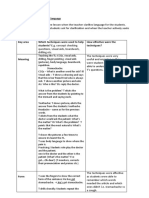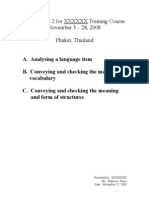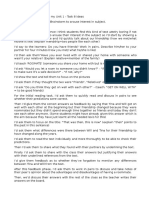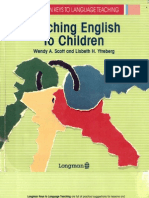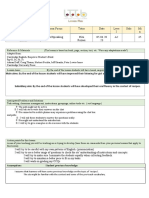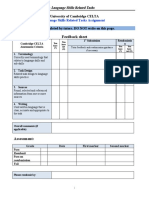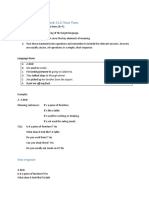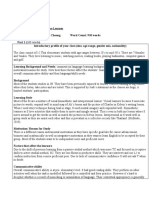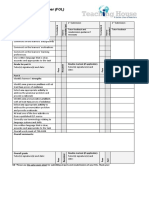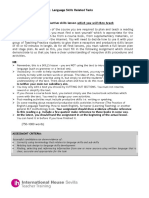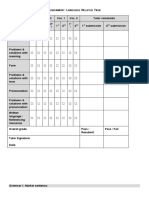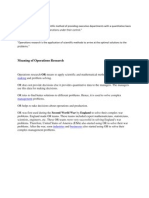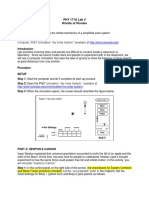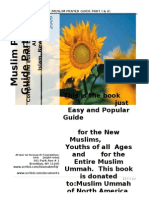Celta Assignment Sample
Celta Assignment Sample
Uploaded by
Светлана КузнецоваCopyright:
Available Formats
Celta Assignment Sample
Celta Assignment Sample
Uploaded by
Светлана КузнецоваOriginal Description:
Copyright
Available Formats
Share this document
Did you find this document useful?
Is this content inappropriate?
Copyright:
Available Formats
Celta Assignment Sample
Celta Assignment Sample
Uploaded by
Светлана КузнецоваCopyright:
Available Formats
CELTA Written Assignment Three - Language skills related assignment
For the purpose of this assignment I have chosen a piece of authentic text - a tale
The Giving Tree by Shel Silverstein, as a suitable material for a reading skills
lesson in an elementary class.
The general level of interest is supposed to be rather high because elementary
students are usually used to reading adapted materials and may be enthusiastic
about reading an authentic text that they can understand. Even though some of
them may find the task challenging, it is likely to be rewarding and fun to cope
with an unadapted authentic tale. Another factor that may add up to their
interest is that this tale is a classic. Since the tale has a deep philosophical
meaning and multiple interpretations, the story has the benefit of being
interesting both to adults and children.
The main aim of the lesson is to develop reading comprehension and practice
reading for gist, specific information and detail with a follow-up speaking activity
for productive skills.
Anticipating problems: 1. Grammar and Lexis: See: pre-teaching Vocabulary and
Grammar. Text: See: Gist reading. Skills: Elementary students tend to read the
whole text for detail. They find it difficult to read for gist and to scan. Their
understanding of the text may also be hampered by the inability to deduce
meaning from context. Solution: I will set time limits and give clear instructions
for each reading activity and explain to students that they dont need to
understand every word in the text and read the text from the very beginning to
the end each time they want to do a new task. I will explain to students that
sometimes they need to scan the text to find the passage they need and then read
it for detail. Cultural: The philosophical aspect of the tale and the fact that it may
seem disturbing to some students is one on the problems that I can anticipate. In
order to deal with the problem, I am setting a follow-up speaking activity for
students to share their opinions and express their ideas about the tale.
Lead-in: I will tell the students about the gifts that I got from my family
and friends and gave to my family and friends. I will tell the students that I
like getting gifts but I like giving gifts more. I will ask the students to
discuss what gifts they got and gave and whether they like getting or
giving gifts more. After the pair discussion and feedback I will tell the
students that they are going to read a tale called The Giving Tree and ask
them to discuss what a tree can give people. The task is aimed at
activating the students schemata on the topic of giving and taking and at
testing and introducing the vocabulary of trees. According to Wallace, if
the mind is stimulated by key words and phrases, it activates a knowledge
schema or schemata1.
Pre-teaching vocabulary and grammar: I am going to pre-teach words
that may impede students understanding of the text: leaves; a branch, a
trunk, a stump. I am not going to pre-teach every word they do not know
so that they could practice the useful skill of deducing meaning from text.
1
Wallace C., Reading, OUP, 1992, p. 33
The students are not likely to know would+ bare infinitive for describing
repeated/habitual actions. I will pre-teach the structure contextualising it
and asking CCQs.
Task 1: Gist Reading2: according to J. Harmer, students need to be able to
skim the text in order to understand its general idea before going into
reading for detail.3 Therefore, the task gives students general
understanding of the text and involves them in further reading. Since it is
a 600-word text, I consider matching the headings with the paragraphs a
useful gist task which will help students to navigate the text easily when
working with scanning and reading for detail tasks.
Task 2: Reading for specific information and detail. As Grellet puts it,
when teaching reading comprehension we should keep in mind that there
is not one type of reading but several according to ones reasons for
reading4. In this task the students have to choose correct endings to
sentences (two options per sentence), which will first require them to
scan the text and find the key words (hide-and-seek, house, boat these
words do not appear throughout the text but in specific passages). Even
though we usually scan for numbers and names, the students will need to
use this strategy working with this text because it is rather long and if
they do not scan it for key words, they will have to read big pieces of text
in order to find an answer to one point. The students will have to scan to
find the correct passage and then read the passage or sentence for detail
in order to grasp its full understanding.
Task 3: Reading for specific information and detail: In this task the
students have to put the stages of the story in the correct order. If Task 2 is
arranged in the chronological order (which makes it easier for students to
scan and read for detail), this task is aimed at students figuring out and
understanding the sequence of events in the story. To complete the task
they will have to scan longer pieces of text till they find the places that will
help them to arrange the sequence.
Task 4: Reading for detail: As Scrivener states5, when we use a top-down
reading approach, exercises aimed at focusing on finer points of meaning
and more intensive comprehensive understanding come after the focus on
more general points of meaning. By the time the students reach this task,
they will have already become familiar with the text and read some of its
pieces more than once. The comprehension questions in this task are
aimed at deeper understanding of the text (e.g. Why was the tree happy
even when it lost its apples, branches and trunk?). There is no direct answer
to these questions in the text. The students can only infer the answers if
they understand the text in detail.
2
The tasks and the keys are attached in the handout
3
Harmer J., How to Teach English, Addison Wesley Longman Limited, 1998, p. 69
4
Grellet, F., Developing Reading Skills: A Practical Guide to Reading Comprehension Exercises, CUP, 1981, p.9
5
Scrivener J., Learning Teaching, Macmillan, 2005, p.187
Follow-up speaking activity
Discussion questions in the follow-up productive activity give the students
an opportunity to share their understanding of the story and to express
their opinions. Students discuss in pairs, small groups and as a whole
class. As Harmer states, a controversial reading passage may be a
springboard for discussion and provide the necessary stimulus for
students to tell their own stories.6
Words: 1083
Bibliography:
Grellet, F., Developing Reading Skills, CUP, 1981
Harmer J., How to Teach English, Addison Wesley Longman Limited, 1998
Harmer J, The Practice of English Language Teaching, Longman, 1991
Scrivener J., Learning Teaching, Macmillan, 2005
Wallace C., Reading, OUP, 1992
6
Harmer J, The Practice of English Language Teaching, Longman, 1991, p. 251
You might also like
- CELTA Assignment 2: Focus On The LearnerDocument3 pagesCELTA Assignment 2: Focus On The LearnerDominic Brecken0% (2)
- 10 Principles of EconomicsDocument3 pages10 Principles of EconomicsGrace Carrasco100% (9)
- The Syn Alia Series On Animal TrainingDocument101 pagesThe Syn Alia Series On Animal Trainingben100% (1)
- CELTA Online Unit 2 Task 13 - Designing TasksDocument2 pagesCELTA Online Unit 2 Task 13 - Designing TasksShalindriNo ratings yet
- Celta Lesson Plan TP - 1Document4 pagesCelta Lesson Plan TP - 1Mumtaz Ahmad50% (2)
- Focus On The LearnerDocument5 pagesFocus On The LearnerHeba MouradNo ratings yet
- Celta: Assignment 3: Skills-Related: Part 2: Receptive Skill Task DesignDocument3 pagesCelta: Assignment 3: Skills-Related: Part 2: Receptive Skill Task DesignBasma Elzeidy100% (1)
- Clarifying Language - Celta Observation TaskDocument3 pagesClarifying Language - Celta Observation TaskAndreea Ionela Vasconcelos SavaNo ratings yet
- Assignment 2 - Maria - Marked PDFDocument10 pagesAssignment 2 - Maria - Marked PDFMaria AvilovaNo ratings yet
- OCT Guide Unit by Unit 06092013Document39 pagesOCT Guide Unit by Unit 06092013mcgwart100% (2)
- Language Related Tasks Assignment C6 2017Document2 pagesLanguage Related Tasks Assignment C6 2017Imran Rahim0% (2)
- Assignment 2 - Language Analysis and MeaningDocument9 pagesAssignment 2 - Language Analysis and MeaningShelia83% (6)
- Assignment 3 - LSRT Skills E - TippingDocument8 pagesAssignment 3 - LSRT Skills E - Tippingbrentcullen50% (2)
- Assignment 3 Language Skills Related TasksDocument2 pagesAssignment 3 Language Skills Related Taskssweetlankka0% (2)
- CELTA Assignment 3 SkillsDocument16 pagesCELTA Assignment 3 SkillsMARCELA100% (1)
- Assignment 2 Siwar - 2020Document14 pagesAssignment 2 Siwar - 2020Siwar Bdioui100% (1)
- CELTA - Assignment 2Document7 pagesCELTA - Assignment 2vligrNo ratings yet
- LRT Celta Part CDocument1 pageLRT Celta Part Csandra vujicNo ratings yet
- Language Related TaskDocument10 pagesLanguage Related TaskCheryl ZhuNo ratings yet
- Lesson Plan 3 CeltaDocument7 pagesLesson Plan 3 CeltaReza JefNo ratings yet
- Lessons From The Classroom Assignment-4Document3 pagesLessons From The Classroom Assignment-4Syrian Eagle100% (1)
- CELTA Assignment 1Document10 pagesCELTA Assignment 1Thomas100% (4)
- CELTA Language Skills Related Task 1Document3 pagesCELTA Language Skills Related Task 1nathalia costaNo ratings yet
- CELTA Language Analysis Sample 1 Lexis AbroadDocument1 pageCELTA Language Analysis Sample 1 Lexis AbroadRebecca Tavares Puetter100% (1)
- Focus On The Learner: CELTA - Written Assignment 1Document6 pagesFocus On The Learner: CELTA - Written Assignment 1Cira Fernandez SanchezNo ratings yet
- Victor Slonzon Piedade UNIT 2 Task 13Document3 pagesVictor Slonzon Piedade UNIT 2 Task 13Victor PiedadeNo ratings yet
- Delta Module 2 Internal LSA2 BE.2Document20 pagesDelta Module 2 Internal LSA2 BE.2Светлана Кузнецова100% (4)
- Balloon DebateDocument5 pagesBalloon DebateСветлана КузнецоваNo ratings yet
- (E-Book) Teaching English To ChildrenDocument119 pages(E-Book) Teaching English To Childrenemmaromera95% (42)
- Environmental Ethics in IslamDocument74 pagesEnvironmental Ethics in IslamAffie SaikolNo ratings yet
- Assignment 3 Language Skills Related Tasks Final DraftDocument3 pagesAssignment 3 Language Skills Related Tasks Final DraftZain SheriffNo ratings yet
- Skills Related TaskDocument5 pagesSkills Related TaskMohamed Osman100% (1)
- CELTA Assignment 3 DementevaDocument6 pagesCELTA Assignment 3 DementevaKhadijah YaNo ratings yet
- Written Assignment 2: Language Related Tasks: Example 2 in The Example Answers Below The Text)Document5 pagesWritten Assignment 2: Language Related Tasks: Example 2 in The Example Answers Below The Text)Maria AvilovaNo ratings yet
- Celta TP2Document7 pagesCelta TP2Doğa Erkan DozzoNo ratings yet
- Assignment 3 LSRT - MiguelLaricoCondori - To CompleteDocument12 pagesAssignment 3 LSRT - MiguelLaricoCondori - To CompleteMIGUEL ANGEL LARICO CONDORINo ratings yet
- Celta Assignment 3Document3 pagesCelta Assignment 3billybobbenjamin75% (4)
- Richard's TP 4Document6 pagesRichard's TP 4R BNo ratings yet
- Celta Written Assignment - Focus On The LearnerDocument2 pagesCelta Written Assignment - Focus On The Learnerses70068100% (9)
- Assignment 1 - LRTDocument5 pagesAssignment 1 - LRTSinzi SocolNo ratings yet
- Assignment 4Document6 pagesAssignment 4Tom McDonald100% (4)
- CELTA Written Assignment: Focus On The Learner-EXAMPLEDocument4 pagesCELTA Written Assignment: Focus On The Learner-EXAMPLEClara Maria Quispe CéspedesNo ratings yet
- CELTA Assignment 4 LFCDocument4 pagesCELTA Assignment 4 LFCLucy MingNo ratings yet
- Focus On The LearnerDocument3 pagesFocus On The LearnerMumtaz AhmadNo ratings yet
- CELTA Online Unit 8 Task 11-3 - Your TurnDocument3 pagesCELTA Online Unit 8 Task 11-3 - Your TurnMaria AvilovaNo ratings yet
- CELTA Assignment 2 Focus On The LearnerDocument10 pagesCELTA Assignment 2 Focus On The Learnerjavad mohammadyNo ratings yet
- Assignment 4 LFCDocument3 pagesAssignment 4 LFCSarshNo ratings yet
- Assignment 4 LFTC (New)Document9 pagesAssignment 4 LFTC (New)Elika MossadeghNo ratings yet
- Celta AssignmentDocument13 pagesCelta Assignmentshilpadub100% (2)
- Assignment 3 - SRTDocument14 pagesAssignment 3 - SRTVan LeNo ratings yet
- Skills Related AssignmentDocument5 pagesSkills Related AssignmentMumtaz Ahmad100% (7)
- CELTA Written Assignment Lessons From THDocument2 pagesCELTA Written Assignment Lessons From THjavad mohammady100% (1)
- CELTA Assignment 1Document5 pagesCELTA Assignment 1magnolia_moog100% (2)
- CELTA Assignment 3 Language Skills RelatDocument4 pagesCELTA Assignment 3 Language Skills RelatIosif DraganNo ratings yet
- FOL ExampleDocument13 pagesFOL ExampleQingqing LuNo ratings yet
- Assignment 1 - FOLDocument7 pagesAssignment 1 - FOLVan LeNo ratings yet
- Language Skills Related TasksDocument3 pagesLanguage Skills Related Tasksمعاذ الاشعريNo ratings yet
- Language Related Task CELTA CourseDocument2 pagesLanguage Related Task CELTA CourseIvano Celentano50% (2)
- Assignment Language Related TaskDocument9 pagesAssignment Language Related Taskaya osamaNo ratings yet
- Assignment 1-Celta Focus On LearnerDocument1 pageAssignment 1-Celta Focus On LearnerHirah Nabil Ali100% (1)
- Focus On The LearnerDocument7 pagesFocus On The LearnerDiana Graur100% (2)
- Dokumen - Tips Celta Assignment 3 SkillsDocument15 pagesDokumen - Tips Celta Assignment 3 SkillsPriyanshu SharmaNo ratings yet
- Ass 3 Alan PASSDocument7 pagesAss 3 Alan PASSmutiso mutie100% (1)
- How To Work With ReadingDocument5 pagesHow To Work With ReadingAlinfa1No ratings yet
- Patterns in Student Teachers Learning Processes and Ou - 2022 - Teaching and TeDocument11 pagesPatterns in Student Teachers Learning Processes and Ou - 2022 - Teaching and TeСветлана КузнецоваNo ratings yet
- Playful Learning Designs in Teacher Education and Earl - 2022 - Teaching and TeaDocument10 pagesPlayful Learning Designs in Teacher Education and Earl - 2022 - Teaching and TeaСветлана КузнецоваNo ratings yet
- Advanced Manual ProjectsDocument22 pagesAdvanced Manual ProjectsValentin Ionescu0% (1)
- TOEFL Words by Meaning-Part1Document10 pagesTOEFL Words by Meaning-Part1Mufid MuyassarNo ratings yet
- Roller Coaster ProjectDocument13 pagesRoller Coaster ProjectEshaqNo ratings yet
- Planning Midterm ReviewerDocument8 pagesPlanning Midterm ReviewerJannah ArandaNo ratings yet
- Content Analysis of PhotographsDocument10 pagesContent Analysis of PhotographsTerry College of BusinessNo ratings yet
- ch14 2 PDFDocument7 pagesch14 2 PDFLeidel Claude TolentinoNo ratings yet
- NBA - Tier II ManualDocument23 pagesNBA - Tier II Manualsaran200579No ratings yet
- Philo Mod1 Q1 Introduction To The Philosophy of The Human Person Print1Document26 pagesPhilo Mod1 Q1 Introduction To The Philosophy of The Human Person Print1Rosario Del PuertoNo ratings yet
- Introduction of TaekwondoDocument28 pagesIntroduction of Taekwondoalex100% (1)
- VISUAL MUSIC MARATHON BookletDocument58 pagesVISUAL MUSIC MARATHON BookletSerban NichiforNo ratings yet
- 6 Behavioural FinanceDocument31 pages6 Behavioural FinanceHuy NguyenNo ratings yet
- The Allied Occupation of Istanbul and The Construction of Turkish National Identity in The Early Twentieth CenturyDocument13 pagesThe Allied Occupation of Istanbul and The Construction of Turkish National Identity in The Early Twentieth CenturyKaya TokmakçıoğluNo ratings yet
- Linguistics-Debut Volume 2 Number 2Document51 pagesLinguistics-Debut Volume 2 Number 2livelife01No ratings yet
- Meaning of Operations Research: Decision MakingDocument3 pagesMeaning of Operations Research: Decision MakingraghuvaraNo ratings yet
- PHY 171A Lab 4Document5 pagesPHY 171A Lab 4james100% (1)
- Assignment 2 Rubrics June 2022Document3 pagesAssignment 2 Rubrics June 2022calistaNo ratings yet
- Being A Challenge To Women (& REALLY Turning Them On) - Girls ChaseDocument37 pagesBeing A Challenge To Women (& REALLY Turning Them On) - Girls ChaseJames75% (4)
- Chaudhry Ranbir Singh: A Short Political Biography.Document138 pagesChaudhry Ranbir Singh: A Short Political Biography.Ranbir Singh ChaudhryNo ratings yet
- African DramaDocument15 pagesAfrican DramaMichelle RangesNo ratings yet
- Muslim Prayer Guide Part I and IIDocument545 pagesMuslim Prayer Guide Part I and IIislamakmfi100% (1)
- Simple Sentence Structure of Standard Arabic Language PDFDocument25 pagesSimple Sentence Structure of Standard Arabic Language PDFtomasgouchaNo ratings yet
- Devlok With Devdutt PattanaikDocument194 pagesDevlok With Devdutt PattanaikSabyasachi Mukhopadhyay88% (8)
- Preparing For The Reciprocal System (V Krishna, Gopi)Document20 pagesPreparing For The Reciprocal System (V Krishna, Gopi)Gerson MonteiroNo ratings yet
- A Timeline of Events in ElectromagnetismDocument7 pagesA Timeline of Events in ElectromagnetismGlenmar Alejandro VinegasNo ratings yet
- CaesuraDocument21 pagesCaesuram54237No ratings yet
- Redesain Pasar Cepogo Dengan Pendekatan ArsitekturDocument8 pagesRedesain Pasar Cepogo Dengan Pendekatan ArsitekturNanang MaitaNo ratings yet
- PDF Inductive Reasoning Experimental Developmental and Computational Approaches 1st Edition Aidan Feeney DownloadDocument84 pagesPDF Inductive Reasoning Experimental Developmental and Computational Approaches 1st Edition Aidan Feeney DownloadpuhanparissNo ratings yet







